 Before I get into this chaotic exotic city of Marrakech, I’d like to explain that Moors never existed in ancient Morocco. There were no Moors when the Phoenicians traded along the coast of North Africa in 1000 BC. There were no Moors when the Romans conquered Carthage and extended the empire in the 1st century BC. There were no Moors when the Umayyad Caliphate of Mecca sent Tariq Ibn Ziyad across the Straits of Gibraltar in 711 and conquered Spain. There were no Moors in the Almoravid Dynasty that ruled Northern Africa and Spain in the 11th and 12th centuries nor the Almohads of the 12th – 13th centuries. The name Moor seems to be entirely a western European invention.
Before I get into this chaotic exotic city of Marrakech, I’d like to explain that Moors never existed in ancient Morocco. There were no Moors when the Phoenicians traded along the coast of North Africa in 1000 BC. There were no Moors when the Romans conquered Carthage and extended the empire in the 1st century BC. There were no Moors when the Umayyad Caliphate of Mecca sent Tariq Ibn Ziyad across the Straits of Gibraltar in 711 and conquered Spain. There were no Moors in the Almoravid Dynasty that ruled Northern Africa and Spain in the 11th and 12th centuries nor the Almohads of the 12th – 13th centuries. The name Moor seems to be entirely a western European invention.
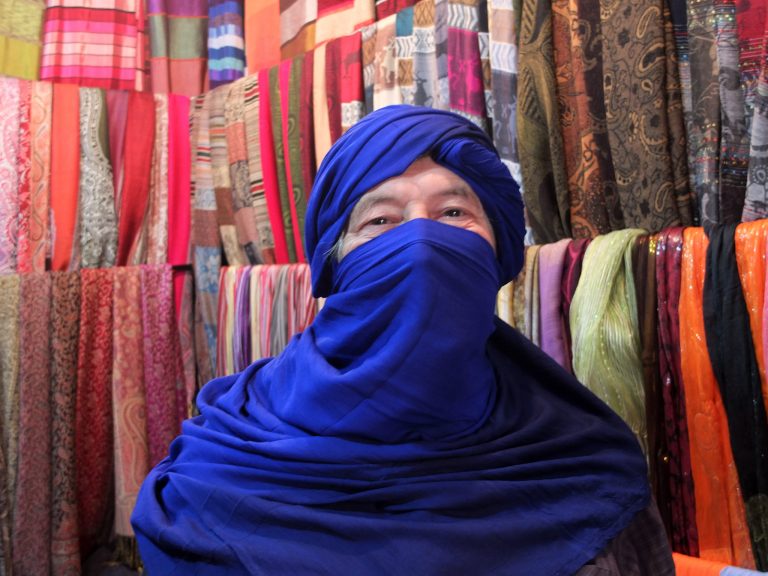 Since the 6th century, the tribes of Morocco have referred to themselves as Berber, a Vandal corruption of the Greek/Latin word “barbaria” which meant from outside the Empire. All people outside of Greece were called Barbari. The Romans (who incorporated a lot of Greek culture) kept the name, and considering the Roman Empire stretched from Africa to Germany and Britain to Persia, there were a lot of “Barbari”.
Since the 6th century, the tribes of Morocco have referred to themselves as Berber, a Vandal corruption of the Greek/Latin word “barbaria” which meant from outside the Empire. All people outside of Greece were called Barbari. The Romans (who incorporated a lot of Greek culture) kept the name, and considering the Roman Empire stretched from Africa to Germany and Britain to Persia, there were a lot of “Barbari”.
Some believe the name “Moor” originated from the Roman colony of Mauretania which comprised the northern African coastal countries of Libya, Morocco and Algeria.
Some believe that since the Latin name for Marrakech was “Morrock”, the people were called Moors.
Another explanation could be when the Almoravid ruled over Andalusian Spain in the 11th century, they referred to Marrakech as “Mournakoush”.
I personally believe the Spanish coined the name “Moor”. After all, the people from France were called French, from Italy, Italians, from Germany, Germans. Why not call the people from Mournakoush, Moors.
Less than 100 years after the locals tribes began referring to themselves as Berber they were defeated by in 682 by Uqba ibn Nafi, the Umayyad General from Damascus who conquered all of Tunisia, Morocco, Libya and Algeria. As the legend goes, when he finally reached the Atlantic ocean he rode into the surf and declared, “Oh god, if my course was not stopped by this sea, I would still go on, to the unknown kingdoms of the West, preaching the unity of the holy name and putting to the sword the rebellious nations who worship other gods than Allah.”
Uqba ben Nafi never did conquered any more nations in the name of Allah. In fact, a year after he reached the Atlantic, he was killed by one of the recently conquered Berber tribes. He was on his way home to Damascus.
The Umayyad rule lasted about 100 years. There were a few Berber alliances ruling from different parts o the country but by the 11th century, an alliance of Berber tribes known as the Almoravid established Marrakech as it’s capital city and assumed total control of Morocco, Spain, Portugal and the Balearic Islands.
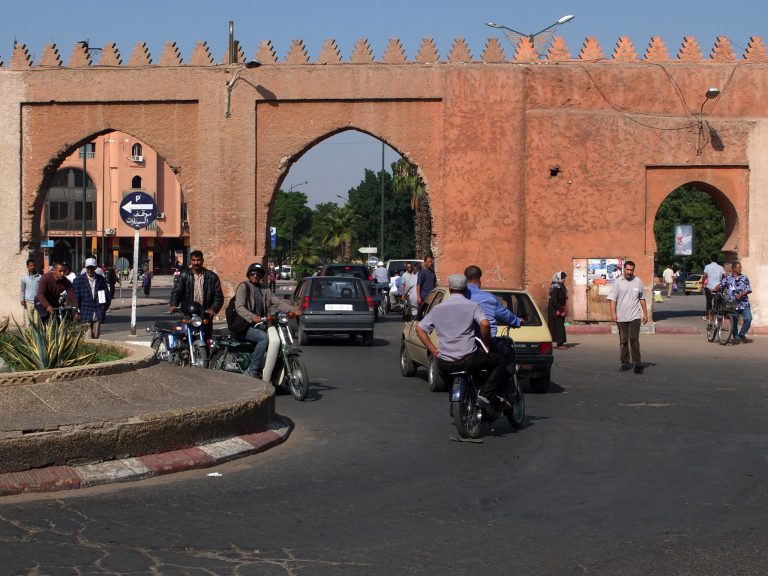 However, by 1147, the good times ended. A rival alliance of Berber tribes known as the Almohad defeated the Almoravid and destroyed any memory of them in the capital city Marrakech. The only thing they kept was the 12 miles of the 20’ tall wall that surrounded the ancient city. The 12th century wall still stands. It’s been maintained for over 850 years. There are over 20 gates and 200 towers. The red/orange color of the clay bricks used to build the wall have given the city the name “The Red City.”
However, by 1147, the good times ended. A rival alliance of Berber tribes known as the Almohad defeated the Almoravid and destroyed any memory of them in the capital city Marrakech. The only thing they kept was the 12 miles of the 20’ tall wall that surrounded the ancient city. The 12th century wall still stands. It’s been maintained for over 850 years. There are over 20 gates and 200 towers. The red/orange color of the clay bricks used to build the wall have given the city the name “The Red City.”
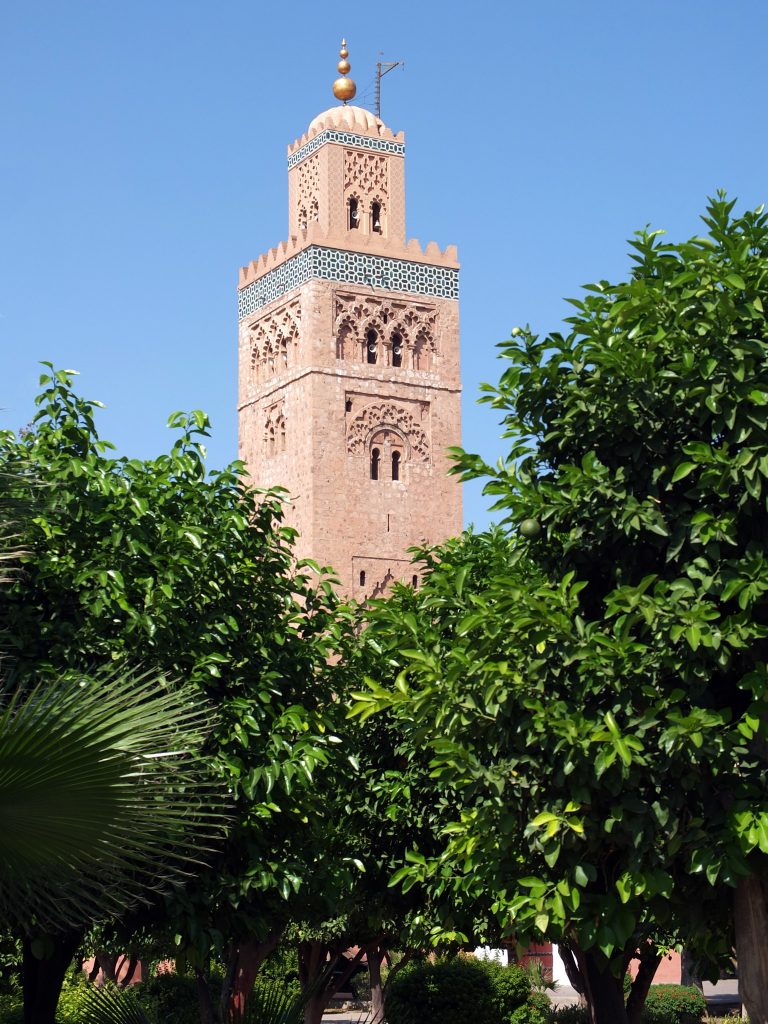 The new Almoravid city planners brought in craftsmen and artists from Andalusian Spain to rebuild the city. The 12th century Koutoubia Tower is the symbol of the city. It’s 253’ tall (inclusive of the spire and gold balls). The tower used to be covered in a pink/beige plaster but in the 1990’s it was reverted back to the original red brick, an improvement appreciated by everyone. The original Almoravid Mosque and Minaret were torn down when the Almohads came in. This newer version, although still pretty old, was finished in 1199.
The new Almoravid city planners brought in craftsmen and artists from Andalusian Spain to rebuild the city. The 12th century Koutoubia Tower is the symbol of the city. It’s 253’ tall (inclusive of the spire and gold balls). The tower used to be covered in a pink/beige plaster but in the 1990’s it was reverted back to the original red brick, an improvement appreciated by everyone. The original Almoravid Mosque and Minaret were torn down when the Almohads came in. This newer version, although still pretty old, was finished in 1199.
At the top of the Minaret are three golden balls surmounted by a tear, which according to legend are a gift from Abu Yusuf Ya’qub al-Mansur’s wife who melted down all of her jewelry in penance after eating three grapes during the Ramadan fast. It’s a good story but the balls are painted gold.
Most of the 12th century building boom was done under the guidance of Sultan Abu Yusuf Ya’qub al-Mansur, one of the great Islamic architectural and art patrons of the age. He was also responsible for the Islamic buildings of Seville, Spain. In fact, the Giralda Tower in Seville and the Koutoubia Tower of Marrakech were conceived and built by the same craftsmen.
Ya’qub al-Mansur also gave refuge and support to some of the greatest philosophers, physicians, astronomers and botanists of the era, including the Andalusian Philosopher, Averroes and the Jewish Philosopher, Moses Maimonides. Both of them were a part of the Golden Age of Cordoba in the 12th century.
The Koutoubia Mosque (Mosque of the Booksellers) was once surrounded with stalls of scribes, bookbinders and booksellers. Now it’s surrounded by a lush and beautiful park.
The Mosque is off limits to non believers like us. Only Muslims are allowed to enter the Mosques in Marrakech. The hypostyle hall of the Koutoubia Mosque has 100 columns supporting horseshoe arches, similar to the Umayyad Mesquita in Cordoba, Spain. Yes, we would have loved to see it, but I very much respect the Mosque for keeping tourists out.
The Almohads ceded power to the Nasrids, who controlled Granada Spain till they lost it to Ferdinand and Isabella in 1492. The Nasrids ceded power to the Marinids who stripped Marrakech of any great value and set up their new capital to the north in Fes.
The 16th century came with the second revival of Marrakech, restored to grand style by the Saadian Dynasty, an Arab family who claimed to be descended from Muhammad’s daughter. It was the end of the Berber rule.
During the reign of Ahmad al-Mansur, Marrakech reached its “Golden Age”. Al-Mansur means “The Golden”. The initial treasure came from the ransoms of wealthy Portuguese, but it was the gold trade across the Sahara that really brought in his wealth and influence in the court of Queen Elizabeth I of England. It was the perfect political alliance. Elizabeth, the Protestant was at odds with Philip, the Catholic of Spain. Al-Mansur wanted to get back control of Spain and set up Muslim colonies in the New World, but unfortunately, Al-Mansur’s gold couldn’t keep up with his lifestyle.
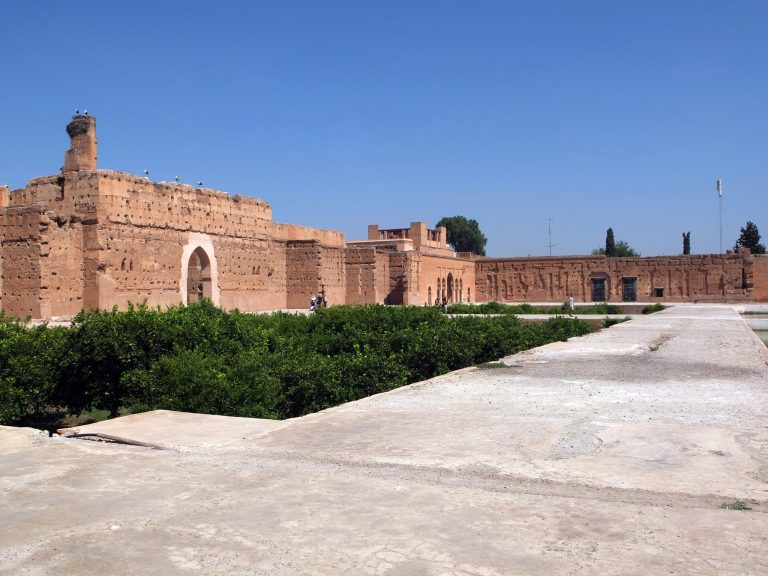 His building masterpiece was the El-Badi Palace. El-Badi means the Magnificent. He started it in 1578.
His building masterpiece was the El-Badi Palace. El-Badi means the Magnificent. He started it in 1578.
It took close to 25 years to complete. Artisans from Italy, France, Spain and India were brought in. Paths were raised over large sunken gardens filled with sweet smelling flowers.
Pools and fountains were everywhere fed by water that flowed from the Atlas Mountains. The Palace had 365 rooms for 365 wives, a wife a day plan.
When the Palace was finally finished in 1603, just a few months before his death, Ahmed al-Mansur asked his court fool to create a worthy compliment of the great palace. The fool replied, “it would make a fine ruin.” That’s exactly what happened to it. By 1696, the Sultan Moulay Ishmail had pretty much stripped everything out of the El-Badi for his new palace in the new extravagant northern capital city, Meknès, about halfway between Rabat and Fes.
In 1917, the Saadian Tombs were rediscovered behind the Kasbah Mosque. It’s one of the most visited sites in Marrakech and there is always a line waiting to see the 12 column pavilion where Ahmad al-Mansur and his immediate family were laid to rest. Yes, it’s a peaceful resting place, bathed in an eerie green light so dark it’s hard to make out the beautiful plaster scrollwork. The short pyramid style grave markers are made of Cararra marble from Italy.
The poorer relations were buried in the grass outside of the pavilions although I prefer the simplicity of the tile and marble grave markers over the pomposity of the pavilion tombs. I just can’t figure out how it was all hidden until 1917. It’s literally right behind the Mosque. I guess no one ever went around the corner to see what was there.
The year 1666 marked the beginning of the Alaouite Dynasty in Morocco, not to be confused with the Alawites of Syria. The Alaouite are another Arabian family who also claim ancestry to Fatima, Muhammad’s daughter are a Sunni Dynasty. The Alawite are a mystical group of Shia Muslims mostly living in Syria.
The reign of the Alaouite was somewhat interrupted by French control from 1912 through 1955, even though the Sultans who ruled as French puppets were still members of the Alaouite family. The free Moroccan dynasty was restored in 1955 and still rules today. Mohammed VI, the current Alaouite King was crowned in 1999. Since 1963, Morocco has been ruled by a Parliamentary Government, the same year Mohammed VI was born. He is loved by the people and is considered a benign Monarch. Although the main Royal Palace is in Rabat, the Royal family still keeps the El-Bahia Palace in Marrakech. It’s closed to the public but the extensive royal gardens are open for viewing on weekends.
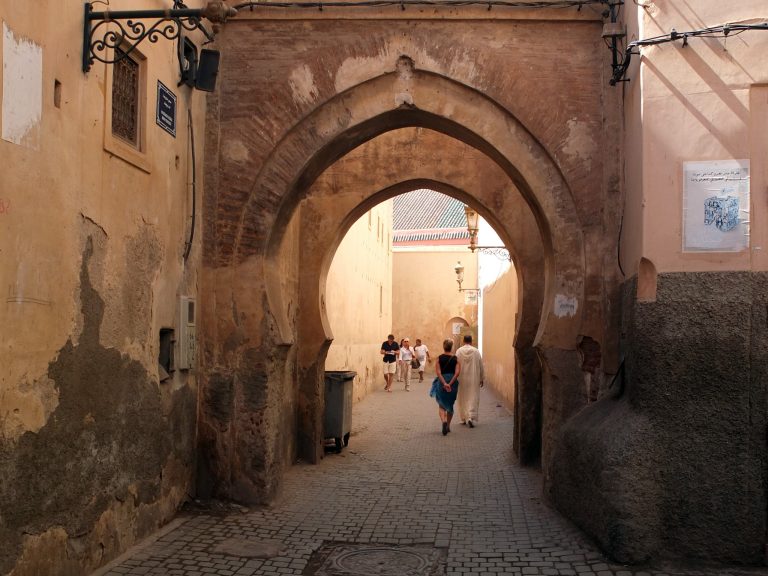 The Medina of Marrakech is a maze of small streets leading somewhere, but no one really knows where. One of the pastimes of the local youth is to approach a confused tourist and offer to lead them to their destination. Tourists for years have been warned about these guys. They’ll take you on a long walk to no-where and then extort money for their services. Over the years tourists have gotten smart about the scam so now the same guys walk up to you and swear they are not guides and swear to you they don’t want any money and swear to you that they are just on their way to school and the place you want to go is in the same direction. Once you agree, they’ll take you on a long walking tour to no-where and then ask for payment.
The Medina of Marrakech is a maze of small streets leading somewhere, but no one really knows where. One of the pastimes of the local youth is to approach a confused tourist and offer to lead them to their destination. Tourists for years have been warned about these guys. They’ll take you on a long walk to no-where and then extort money for their services. Over the years tourists have gotten smart about the scam so now the same guys walk up to you and swear they are not guides and swear to you they don’t want any money and swear to you that they are just on their way to school and the place you want to go is in the same direction. Once you agree, they’ll take you on a long walking tour to no-where and then ask for payment.
Here’s the best advice I can give you when getting lost in Marrakech Medina. Go to the most responsible looking person you can find. I like restaurant owners or shop keepers. Ask them. They’ll get you closer but you’ll have to ask at least 3-4 times before you get there.
There are signs telling you the direction to Jemaa el-Fnaa, the main square and in may cases, it’s best to just go to Jemaa el-Fnaa and work your way back through the Souks.
Jemaa-el-Fnaa is one of the most famous squares in Morocco. It’s a non stop carnival of entertainment. The name translated to “Assembly of Malefactors” when it used for public executions but over the years it was enlarged and now it’s the center of life in old Marrakech. During the day the square is filled with orange juice and dried fruit stalls, snake charmers, musicians, pickpockets, con artists, henna artists, tarot card readers, dancing boys with finger bells, acrobats, tour guides, tourists, donkeys, water porters, souvenir shops, hat and bag vendors, motor scooters, pick up trucks and Kalesh Horse Carriages. By the way, the word Kalesh in Hindi means to cause agitation and discomfort.
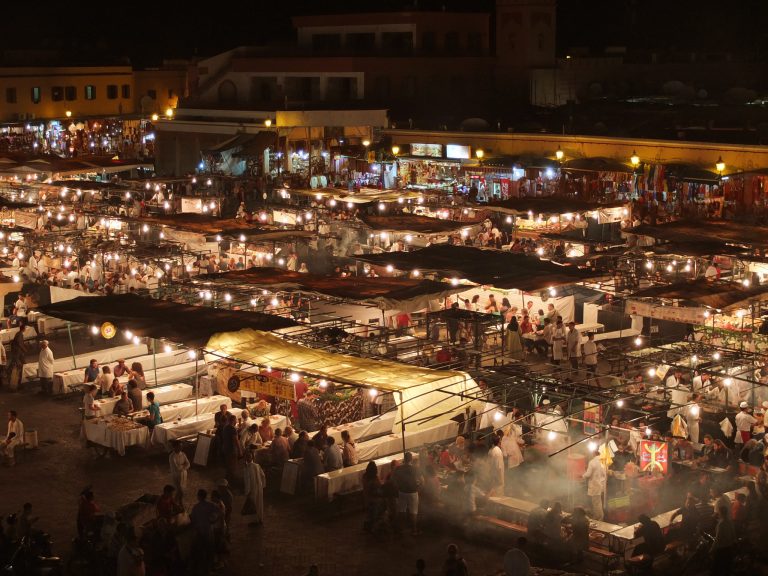 At night Jemaa el-Fnaa completely changes. At about 4:30pm the restaurants start their set up. There are about 40 pop up restaurants across the square each one with different offerings: snails, soup, couscous, tagine, mint tea, kebab skewers, fish, lamb, chicken, pigeon and beef. As you walk by to check out the scene, food hawkers with plastic cards grab hold of you and insist on placing you at one of their tables. We decided to go to a place that had lots of people eating there.
At night Jemaa el-Fnaa completely changes. At about 4:30pm the restaurants start their set up. There are about 40 pop up restaurants across the square each one with different offerings: snails, soup, couscous, tagine, mint tea, kebab skewers, fish, lamb, chicken, pigeon and beef. As you walk by to check out the scene, food hawkers with plastic cards grab hold of you and insist on placing you at one of their tables. We decided to go to a place that had lots of people eating there.
The food comes fast. It’s all precooked and ready to go, sometimes it’s a little overcooked but it sure looks good on the table and it’s a lot of fun.
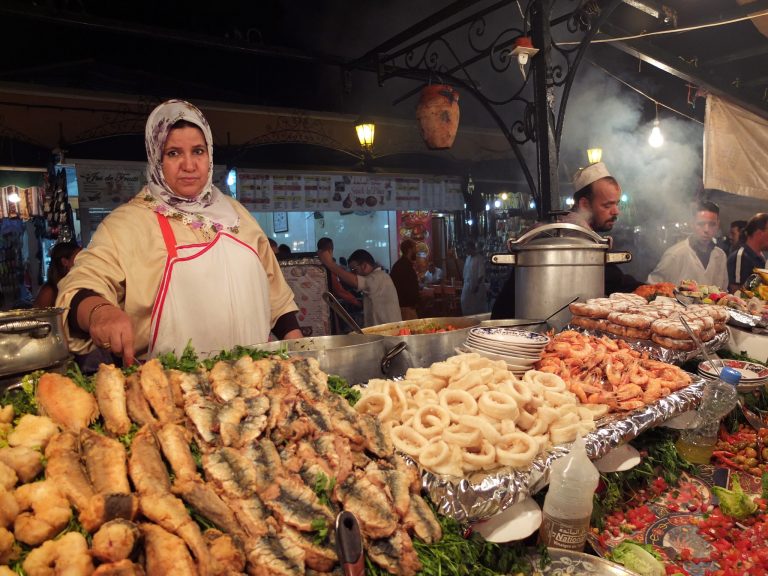 The food tents are just half of the entertainment of Jemaa el-Fnaa at night. There is the constant pulse of street drummers on tam-tams, darbouka and other clay drums covered in tight skins, the whining chant of the Moroccan ghita , the reed flute that charms old cobras to dance for a few dirhams. Colorful costumed men with large lampshade style hats stroll by playing their qraqeb hand cymbals and selling glasses of cold water. Bowed Rebabs, the 3 string goatskin banjos and 10 string Ouds accompany story tellers as they shout over the din and entertain the crowds of locals and tourists. Women with their heads and faces covered grab at you as you walk by to sell a bracelet or offer a henna tattoo. Tourists pose for photos with large Moroccan monkeys in diapers climbing on their backs. Through the crowd are acrobats, street vendors, hashish salesmen and pickpockets. Cameras are snapping up the scene like bread sopping up gravy and with each click of the camera lens, locals Moroccans run up to the photographer with outstretched hands demanding money for the photo. The locals don’t like having their photos taken and it is an extreme rudeness to them for someone to snap them without their permission. The usual compensation is 10 dirham (about $1.20).
The food tents are just half of the entertainment of Jemaa el-Fnaa at night. There is the constant pulse of street drummers on tam-tams, darbouka and other clay drums covered in tight skins, the whining chant of the Moroccan ghita , the reed flute that charms old cobras to dance for a few dirhams. Colorful costumed men with large lampshade style hats stroll by playing their qraqeb hand cymbals and selling glasses of cold water. Bowed Rebabs, the 3 string goatskin banjos and 10 string Ouds accompany story tellers as they shout over the din and entertain the crowds of locals and tourists. Women with their heads and faces covered grab at you as you walk by to sell a bracelet or offer a henna tattoo. Tourists pose for photos with large Moroccan monkeys in diapers climbing on their backs. Through the crowd are acrobats, street vendors, hashish salesmen and pickpockets. Cameras are snapping up the scene like bread sopping up gravy and with each click of the camera lens, locals Moroccans run up to the photographer with outstretched hands demanding money for the photo. The locals don’t like having their photos taken and it is an extreme rudeness to them for someone to snap them without their permission. The usual compensation is 10 dirham (about $1.20).
The Moroccan dirham has been used since the 6th century Byzantine empire. The word is a variation of the Greek Drachma. The Greek Drachma goes back to 1100 BC but since Greece moved over to the Euro, the Dirham became the oldest currency of the western world.
At the corners of the square are balconies on top of the surrounding building where you can get a bird’s eye view of the magic chaos. Entrance is “kind of” free. You have to buy a “consumable”. A soft drink on the balcony is 30 dirham (about $3.75) which isn’t really that bad considering the location, the view and the show below.
The buildings along the square are 2 story, occasionally with a small tower on top. This all corresponds to the building code that no building can be taller than the palm trees of the Medina, less than 20’ tall. In the newer city, the Hivernage, the law is that no building can be taller than the Koutoubia Tower and very few buildings are taller than 3 stories.
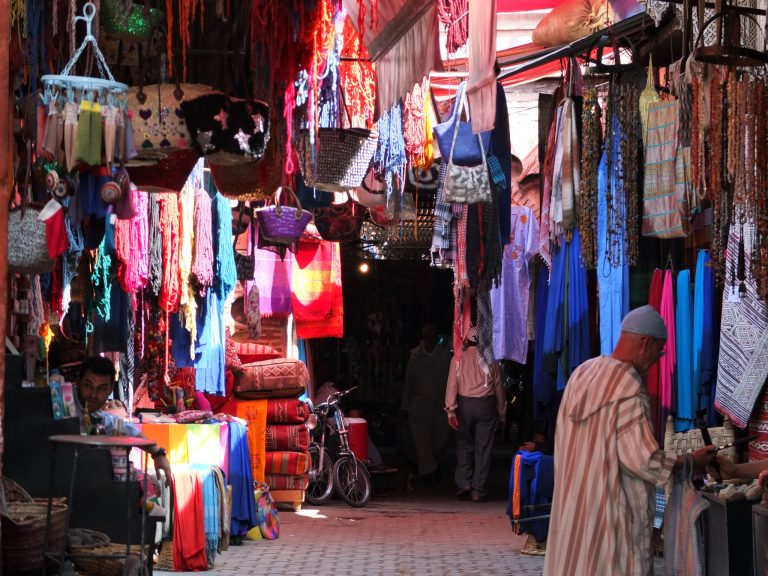 Our days in the Medina were mostly spent getting lost. There are maps with general locations of the Souks, the squares and the Kasbah but you can look at the map as long as you want. You’ll still never find your way out.
Our days in the Medina were mostly spent getting lost. There are maps with general locations of the Souks, the squares and the Kasbah but you can look at the map as long as you want. You’ll still never find your way out.
We did talk to someone who told us he could use his GPS to find places from his Riad Hotel to locations nearby, however, the GPS only worked in one direction. They were on their own to find their way back.
Aside from trying to find a responsible looking person to give you directions, you can also hire the services of a guide. A good guide is a great idea for your first day in Marrakech. You’ll get the history, the culture and the souks. If you are interested in buying anything, the guide will also help you make a good price.
There are two kinds of shops; fixed price, you’ll see the sticker on the item, or no prices, where everything is negotiated.
Because westerners are not used to negotiating, the shop vendor will inevitable get the best price. A local guide can level the playing field.
 As far as a good guide, I recommend Mustapha El Farissi. He is a wonderful man, a very good guide and a great negotiator.
As far as a good guide, I recommend Mustapha El Farissi. He is a wonderful man, a very good guide and a great negotiator.
You can reach him at m.elfarissi@hotmail.fr or call him at +212-06.61.42.98.90. We spent 3 hrs with Mustapha on our first day and got a great introduction to the history, the Medina, the Fondouks, the community bakers, the artisan co-operatives, the Souks and some choices of museums to visit.
Fondouks were Marketplace/Inns for traveling merchants. The Persian word “Karvansera” was translated by Westerners to “Caravanserei”. Fondouk is the Arabic word, still used in Morocco.
There were shops on the ground floors and sleeping quarters on the next floor up. The courtyard was used for communal meals and sleeping arrangements for the camels and horses. The Fondouks are still in the old Medina but we never saw any camels. We did see lots of mules, goats and sheep. The Medina was once filled with Fondouks. There are barely 140 of them left.
The Souks are a whole other kind of merchant experience. These are open air marketplaces. The term is Arabic and Berber and probably hit the Western lexicon during the French occupation of Morocco in the 19th and 20th centuries. Whereas a Fondouk was an Inn with a marketplace, a Souk could be set at any time, on weekends, festivals, or visiting Caravans. They weren’t originally built as permanent markets but somehow along the years in the Medina, they grew into a one stop, all inclusive fabrication to point of sale marketplace. They’re similar to the Bazaars of Istanbul in color, odor and chaos but the souks of Marrakech are factories spinning and dying wool, scrolling filigree metal lanterns, hammering and polishing metal tea sets, bowls, plates and even bath tubs, laboring over fabulous Arabesque plaster scrollwork, tanning and dying leather, sewing leather bags, belts, jackets and shoes, mixing herbs and curing olives and spices. There is even a Souk for tailors making clothing and offering alterations. It’s the largest collection of old world craftsmen we’ve ever seen. Some of the souks create the goods and sell them next door. Others just sell items made in other parts of Morocco (or possibly from China).
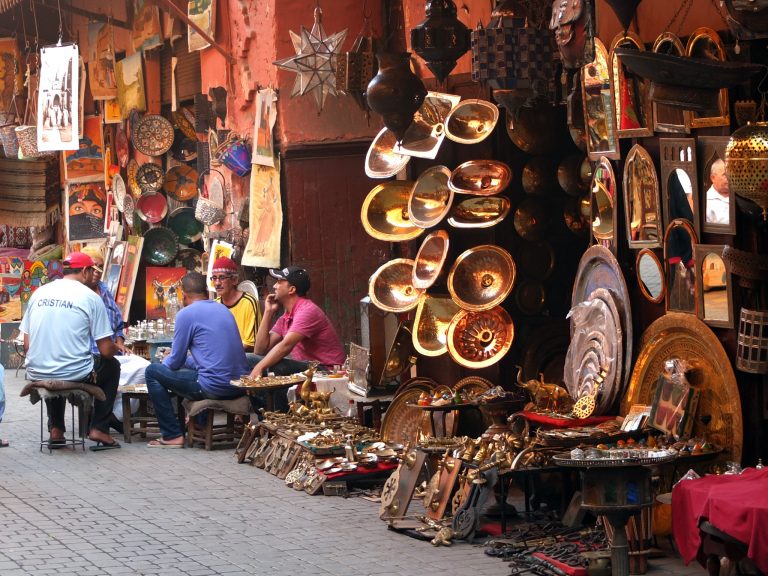 We’d follow our ears into the Souk Haddadine, the blacksmith’s quarter, where clanging of hammers and sparks from welding torches ignite the dark passageways. The shops selling the fabrications from the Souk are a little further away but they are worth stopping in. The globe filigree lanterns are enchanting, the large plates and bowls are pure luxury and the tea sets are magical. Tea in Morocco is a unique experience. The teas set includes the teapot and three bowls; a small bowl for black gunpowder tea, a medium bowl for mint tea and a large bowl for sugar. Put them all together in this ratio and you’ll have Moroccan mint tea, the national drink.
We’d follow our ears into the Souk Haddadine, the blacksmith’s quarter, where clanging of hammers and sparks from welding torches ignite the dark passageways. The shops selling the fabrications from the Souk are a little further away but they are worth stopping in. The globe filigree lanterns are enchanting, the large plates and bowls are pure luxury and the tea sets are magical. Tea in Morocco is a unique experience. The teas set includes the teapot and three bowls; a small bowl for black gunpowder tea, a medium bowl for mint tea and a large bowl for sugar. Put them all together in this ratio and you’ll have Moroccan mint tea, the national drink.
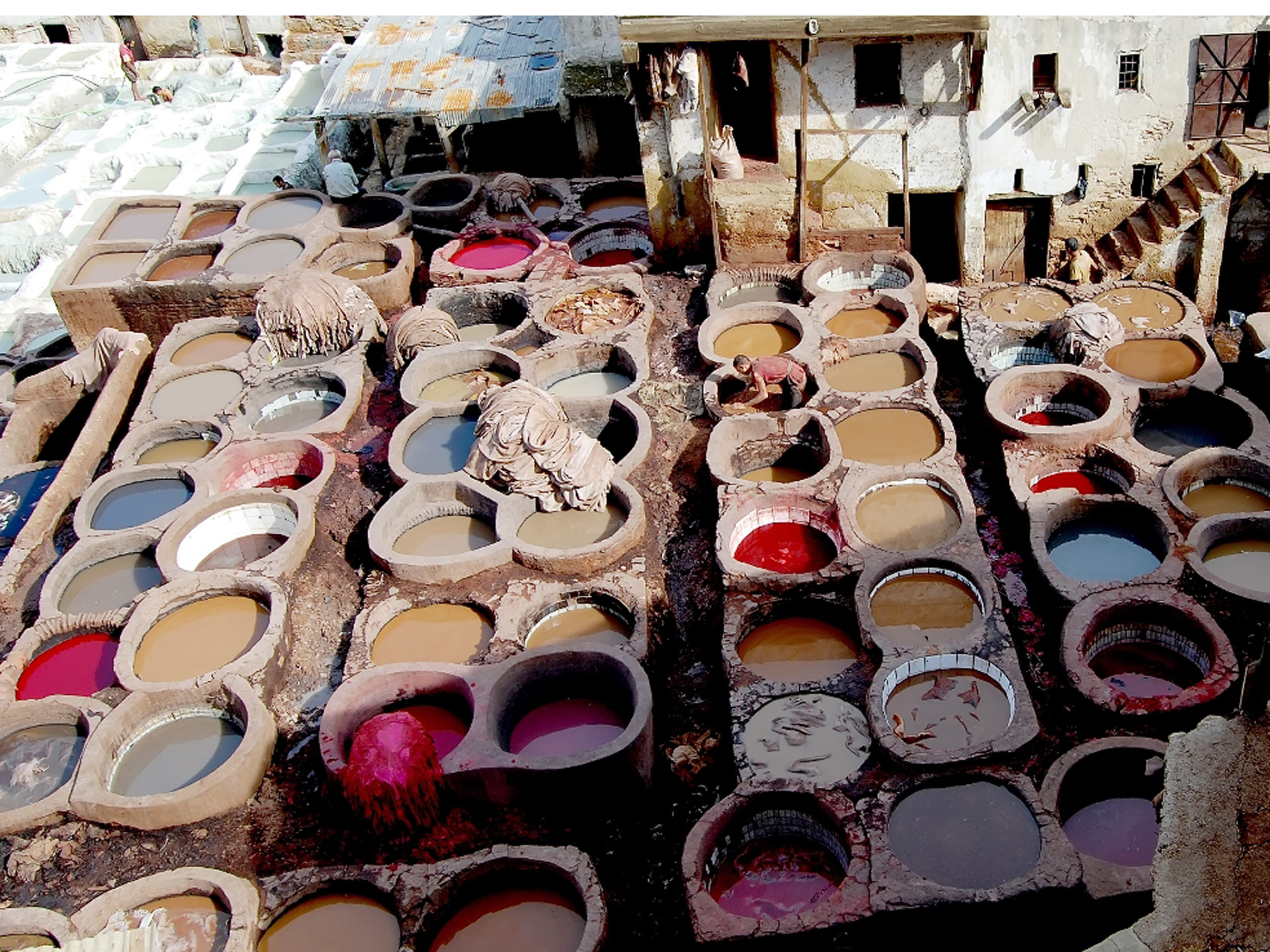 We follow our noses to the Bab (Gate) Debbarh to get to the leather tanneries where large vats are filled with cow urine, pigeon poop and other odious acids.
We follow our noses to the Bab (Gate) Debbarh to get to the leather tanneries where large vats are filled with cow urine, pigeon poop and other odious acids.
They’ve been tanning hides like this since this in the same place since the 11th century.
Further down into the Tannery souk, they sell the piles of tanned skins in large auctions and a little further away, the new owners, cut them up to size, dye them various colors and let them cure in the sun. From there, they are taken to the small shops of craftsmen and made into bags, belts, shoes and jackets. It all happens from start to finish in an area of a few blocks.
The French were so impressed with the tanneries they took to calling all leather goods “maroquinerie”. Leather goods in France are still known as “maroquinerie”.
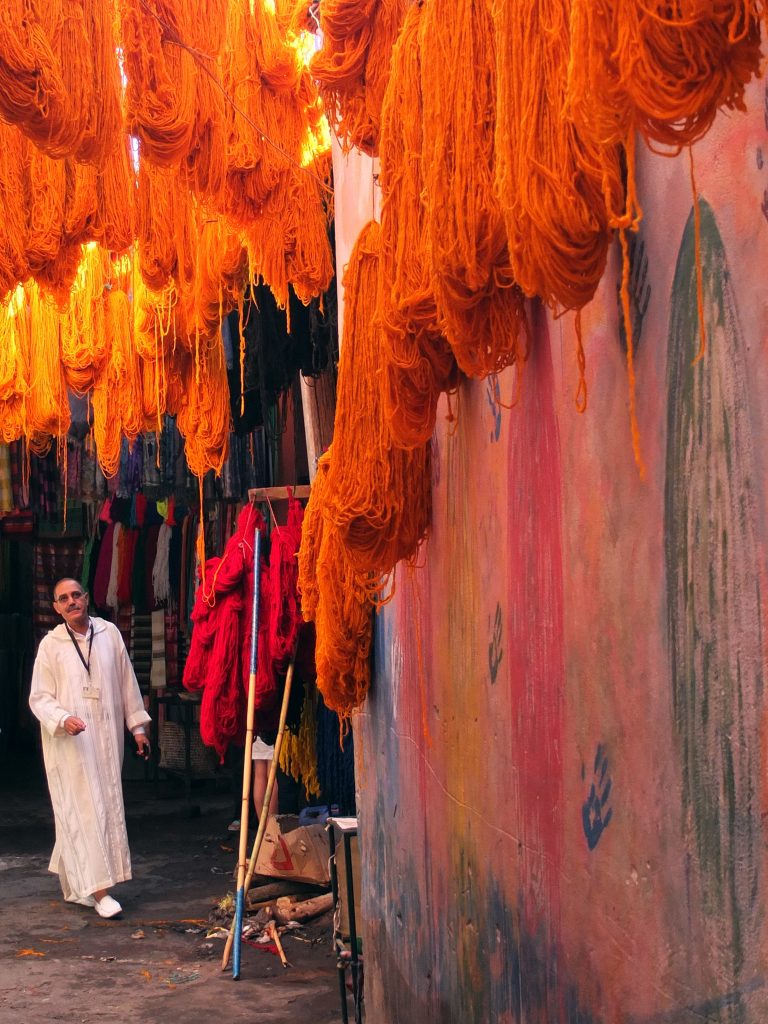 We are caught by the fantastic colors of brightly dyed skeins of wool and agave cactus silk hanging from the walls and ceilings of the Souk des Teinturiers, looking like psychedelic spaghetti. It does sound strange but when the strands of the the agave cactus are woven they have the feel of fine silk.
We are caught by the fantastic colors of brightly dyed skeins of wool and agave cactus silk hanging from the walls and ceilings of the Souk des Teinturiers, looking like psychedelic spaghetti. It does sound strange but when the strands of the the agave cactus are woven they have the feel of fine silk.
The colors are made of indigo, pomegranate, saffron, mint, poppy and lead sulfite. The green powder turns the wool fuschia, dark red powder turns it blue, brown turns red. It’s a magic show as the foreman of the dye shop sets out a dozen small bowls and quizzes the tourists what color will turn up when he adds water. once he gets their attention he goes into the sale and brings them into the room filled with the finished scarves.
If he does his job well, you’ll walk out of there with a few new scarves and many dirham lighter.
The clean white wool is dipped into steaming vats of vegetable dye. It’s not an easy job. The vats have no ventilation as they dip the wool and suck on cigarettes. They probably barely breathe 8 hrs of fresh air a day. They are covered with the color of the day, which probably mixes with the color of the next day. They don’t appreciate the tourists gawking at them as if they were put on display in a carnival act but they will let you take their photo for 10 dirham.
We watch the turtles and lizards in small cages awaiting their destiny to be part of a magical elixir in the Rahba Kédima, the Magic market.
It used to be a grain market until it became illegal to export grain to Christians. There are still some of the old magic stalls adorned with dried eagles, snakes, foxes, lizards and other strange relics used in love potions and other stimulants but mostly it’s a market of spices and herbal remedies.
Moroccan Argan oil is the most prized Argan oil in the world. It’s used for cardiovascular diseases, cancer therapy, skin disease and hair restoration. Moroccan black cumin seed, amongst other uses, is the best cure for stuffy sinuses and snoring. Just put a teaspoon of the seeds in a piece of cloth, form it into a ball and seal with rubber band, rub the ball into your palms to get it warm and take a deep sniff. It’s amazing stuff. According to legend, the prophet Mohammed said the black cumin seed would cure anything except death. We bought a lot of them both. Gretchen also bought a bunch of magic lipstick, the green lipstick that turns pink on your lips.
Even though we had no intention of buying a Moroccan rug, our guide Mustapha insisted we at least have a look at how they are made in La Criée Berbière and so we witnessed the compulsory demonstration of a couple of women making some carpets, most likely staged for tourists. We were told by Aziz, the rug merchant that in Morocco there are 3 kinds of rug patterns; Arabic, Berber and Moroccan/Jewish, dating back to the times when Jewish craftsmen were a large part of this community. We politely drank the mint tea offered to us. We politely smiled and offered praises of quality and salesmanship to Aziz as we watched his employees unfurl over 30 carpets at our feet and then, we reiterated that we are not in the market for a carpet and we all smiled and left. To be honest, we’ve been caught in the carpet trap before and this time is was a lot easier to escape. Maybe we got out easy because Mustapha was with us.
We’re told that the even though the olives of the Souk Ableuh might look different, most of them come from the same tree. The taste depends on the time of year it was harvested. You can buy them from the bins, the trays or the bottles.
The Souk des Babouches was a landmark for us. We know we were close to our Riad when we started to hear the call “BABOUCHES” ring out from the market. Babouches are Moroccan slippers. They come in every size, color, either in leather or clothe.
A Riad is an old family home converted into a small guesthouse. Some of them are simple and comfortable, some a luxurious. Our Riad, the Riad Kniza is on the luxurious side. Actually, it could be the best hotel experience we’ve ever had, and I’m including every hotel we’ve been to in over 30 countries. Maybe it’s because the Riad Kniza is such a an oasis from the chaos outside. This is a beautiful wood and plaster carved 200 year old family home lovingly restored and updated into 11 fabulous suites. It’s quiet and peaceful, the Hammam is fantastic and the restaurant is rated one of the best in the Medina, serving delicious Harira (chick peas, lentil and green beans soup), Bastilla (flakey pie filled with chicken, eggs and almonds), Tagine (slow cooked meat and vegetables in a conical pottery), Couscous and mezze plates. Even if you don’t stay at the Riad Kniza, go to the restaurant.
The owner, Mohamed Bouskri was one of the most renown antique dealers of Marrakech. His wife still owns an antique art gallery. The Riad is filled with joy and really great taste. Mohamed was also one of the most noted tour guides of famous personalities but now he enjoys just checking up on the guests and leaving the Hotel business to his very capable son, Kamal, one of the most diligent hotel managers I have ever had the pleasure to know. In fact, the entire staff is amazing and we highly recommend the Riad Kniza to anyone looking to visit Marrakech.
The Riad is near the Bab Doukkala, a double horseshoe arched gate in the northwest part of the Medina. The rue Bab Doukkala is a food market of vegetables, spices and fresh chicken. The birds are caged in the back of the shop, weighed while still alive and by the time the transaction has finished the chicken looks like any other chicken in a butcher shop, only this time you really know it’s fresh.
 On our last day in the Medina we set off to find the Souk Smarine, a catch all of everything, clothing, leather, babouches, lanterns and a lot of chaos. It’s the main artery in and out of the souks. We probably walked through it ten times but since the Souks all tend to run into each other, we never noticed it. Being in it is easy. Finding it is a bit more difficult.
On our last day in the Medina we set off to find the Souk Smarine, a catch all of everything, clothing, leather, babouches, lanterns and a lot of chaos. It’s the main artery in and out of the souks. We probably walked through it ten times but since the Souks all tend to run into each other, we never noticed it. Being in it is easy. Finding it is a bit more difficult.
After three days we thought we were getting the layout of the street, recognizing landmarks and feeling a little more confidant in our inner GPS, but in our last day in the Medina, after being totally lost for about 3 hrs and circling the Jemaa el-Fnaa like doodle bugs, we were about to give up and take a cab back to our Riad when a hand touched my shoulder and a calm voice said “just take this street on your right and when there is a variation, always stay to the right. You will get to your Riad.” I turned around to see Mustapha. He was like our guardian angel.
We did venture out of Medina a couple of times. There was the day we went into the Kasbah, the old fortified city, to see the Saadian Tombs and the El Badi Palace, even though one of the fake guides told us the El Badi was closed but he would take us to a better site that not many tourists go to. We ditched him and had a great day at the El Badi ruins.
We also made it over to the Hotel Mamounia, even though a fake guide told us we would not be allowed in because we were not wearing proper clothing but he could take us to see a very beautiful Riad close-by. We ditched him and found our way into the Koutoubia Gardens that lead out to the Grand 1923 Moorish Art deco Hotel of Marrakech. It was the stopover of every well-traveled adventurer throughout the 1900’s. The hotel was recently re-opened in 2010 after another extensive renovation. The colonial splendor of Hitchcock’s 1934 film “The Man Who Knew Too Much” might be gone but the renovation is beautiful and magnificent. This is still one of the greatest hotels in the World.
The original 300 meter long wall of bougainvillea is still there but unfortunately though it wasn’t in bloom when we went to see it. Oh well, it was a great stopover for a drink in the gardens that go on for about 8 acres of fruit trees, fragrant flowers, kitchen herbs, swimming pool, bars, ping pong pavilion. The name Mamounia actually comes from the 18th century Price El-Mamoun who was given the garden by his father as a wedding present. The Hotel came much later.
The Agdal Gardens of the El-Bahia (the Brilliant)Royal Palace is the prize of the city. It’s over 1.5 square miles of fruit trees, olive lines pathways, palm trees and pools.
This is the Marrakech residence of the King built in the 19th century. The garden stretches for miles into the Kasbah, but it’s only open to the public on weekends (fri-3pm-6:30pm; Sat 12pm-6pm). We arrived on a Monday and left early Friday morning.
We definitely have something to come back for. Three days in the Medina is more than enough but we never made it into the architectural treasures of the 15th century Ben Youssef Madrasa school or the home of Yves Saint Laurent and his life partner Pierre Bergé, now the Moroccan Museum of Islamic Art, or the luxurious gardens that separate the chaos from the calm.
Mostly we would come back for days trips to the small villages of the High Atlas mountains or to Ourzazate and the fortified village of Ait Benhaddou, the Hill-town that owns the Moroccan film industry. It’s been used in films from Lawrence of Arabia, The Man who would be King, Babel, The Mummy, Gladiator, Kingdom of Heaven, Kundun, Salmon Fishing in Yemen and more recently Game of Thrones.
There is also the 2.5 hour drive to the 18th century coast fortress city of Essouria. For those Marlene Dietrich and Gary Cooper fans, this was the location of the film “Morocco.”
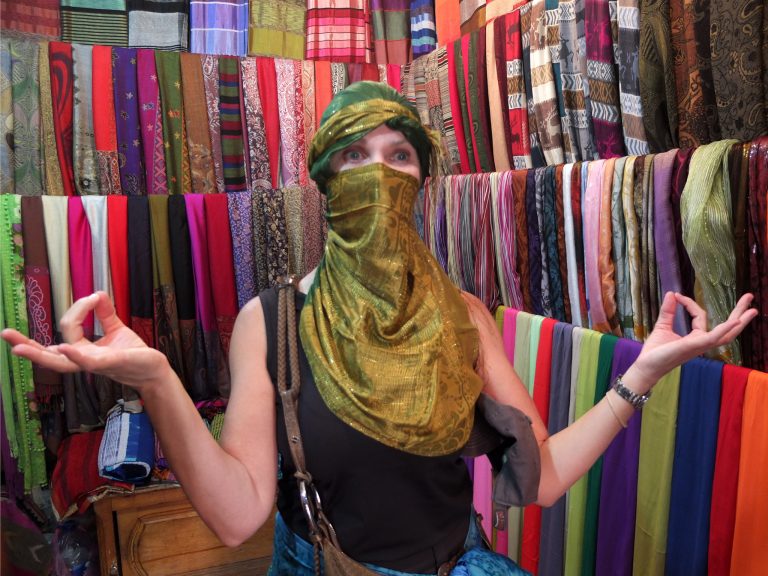 By the time we got to Marrakech we were road weary. We’d been in and out of airports and cars for too long and we just couldn’t get our minds around 6hrs in a car on windy roads. Next time we’ll be more prepared.
By the time we got to Marrakech we were road weary. We’d been in and out of airports and cars for too long and we just couldn’t get our minds around 6hrs in a car on windy roads. Next time we’ll be more prepared.
To see more of our photos of our 2013 visit to Marrakech CLICK HERE
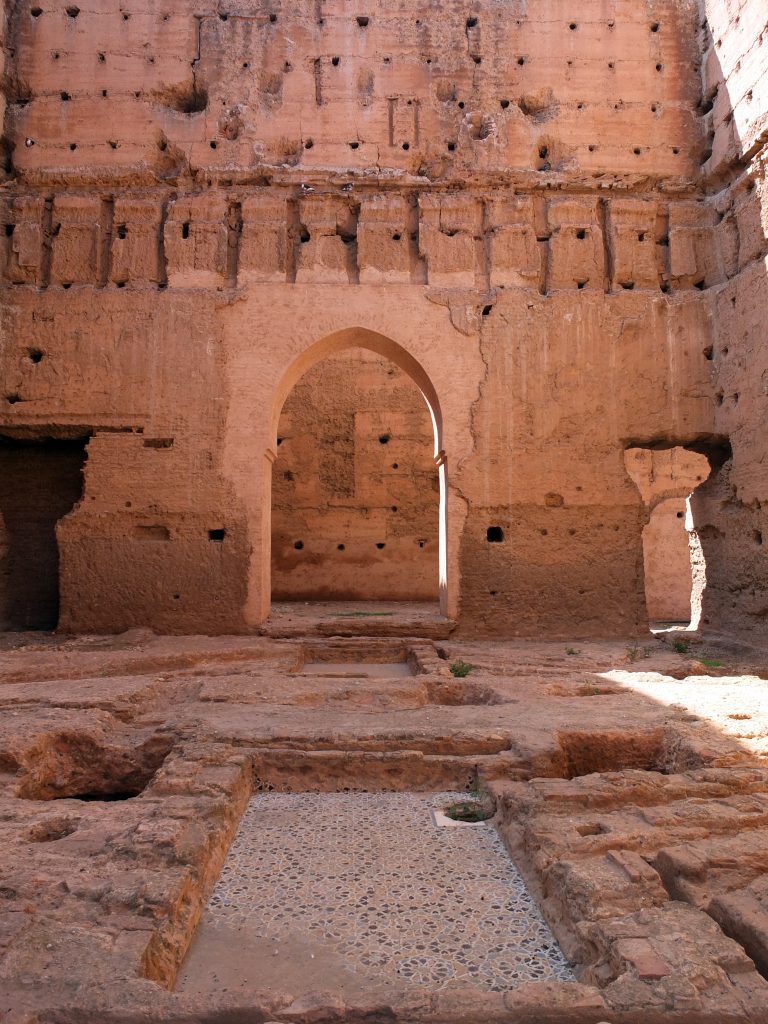
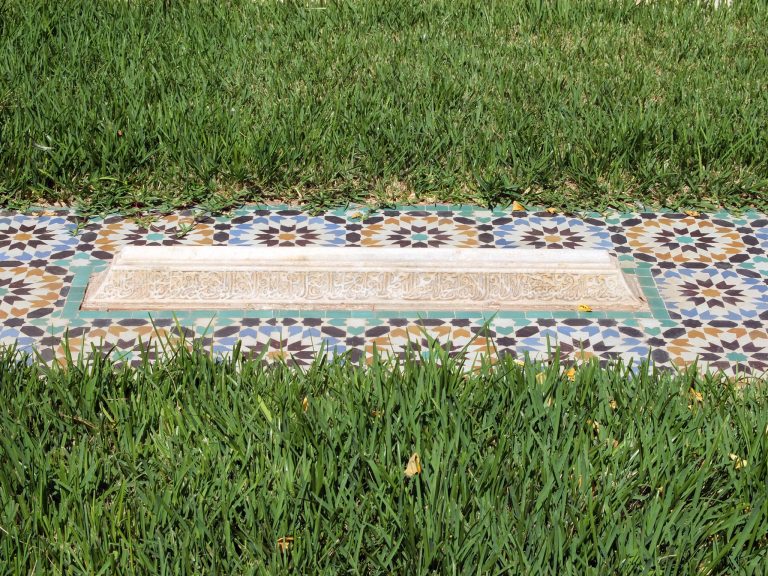
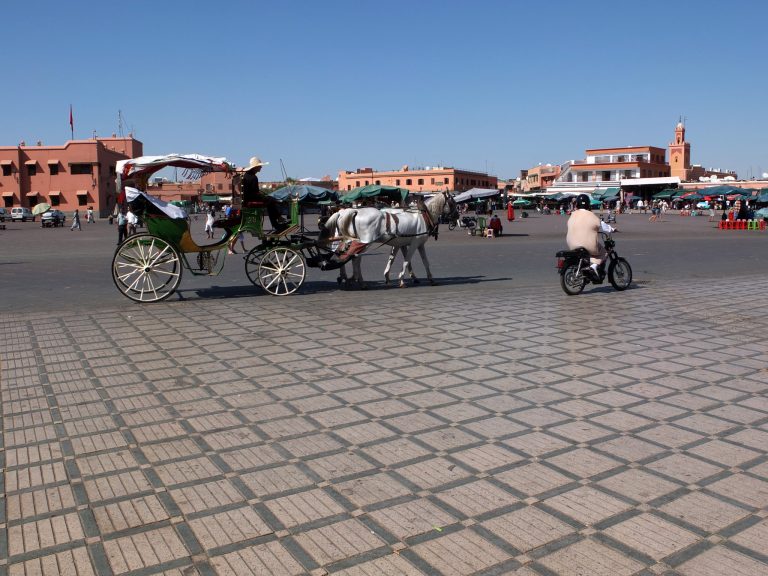

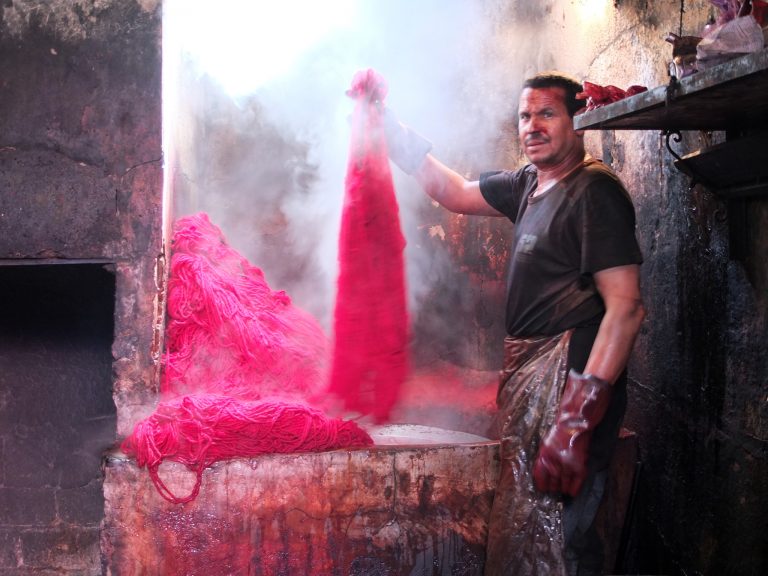
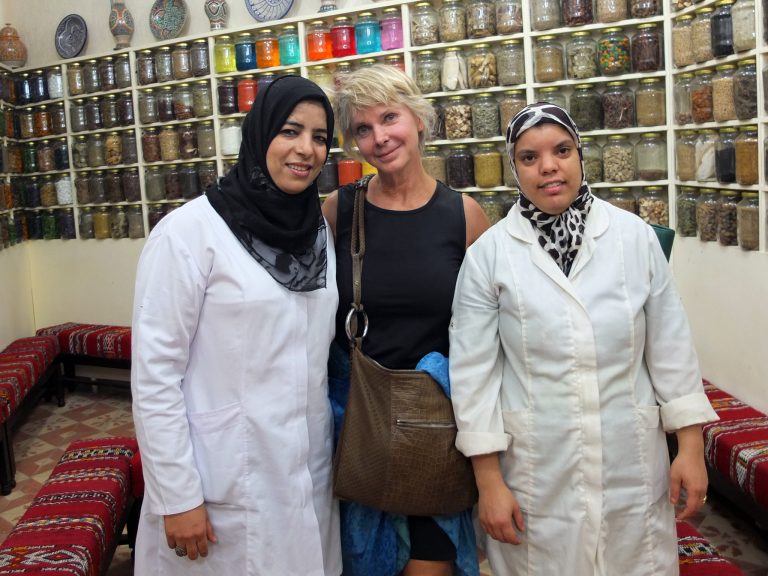
You must be logged in to post a comment.